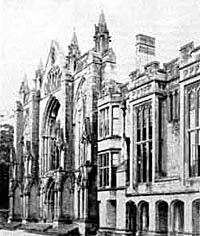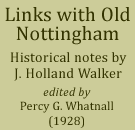< Previous | Contents | Next >
Newstead Abbey
 |
"PRIORATUS Beatae" Maria de novo loco in Shirwood," to give Newstead its full name was not, properly speaking, an abbey at all, but a Priory of Austin or Black Canons.
Newstead was a royal foundation established by Henry II. soon after 1170, and there is a tradition that it was one of the religious houses established by Henry in expiation of the murder of Archbishop Thomas a Becket.
After the dissolution of the convent in 1539 the buildings came into the hands of Sir John Byron of Colwick, who proceeded to make an exceedingly comfortable and livable house out of the monastic buildings. Indeed, one of the many interests of a visit to Newstead is to study the ingenious manner in which the sixteenth century house was fitted into the other buildings.
In 1643, John Byron, who was a staunch loyalist was created first Baron of Rochdale, and it was the fifth Lord Byron who was tried by his peers for causing the death of William Chaworth of Annesley in a duel. On his death in 1798 he was succeeded by his grand-nephew, the poet, but the estate. had been so diminished by the excesses of the fifth Lord Byron that eventually in 1817 Newstead was sold to Colonel Wildman, who undertook a good deal of restoration and alteration. In 1860 it was again sold, this time to Mr. Webb, and a portion of the house now belongs to the City of Nottingham. Since Byron’s days the Abbey has been visited by many celebrated people including the Duke of Sussex and Dr. Livingstone.
At the Dissolution in 1539 the canons packed the title deeds of their property into the great ball of their lectern and threw this lectern into the lake, from whence it was recovered in 1805 and presented to Southwell Minster where it is now in use. Some of these documents are in the Central Free Library of the City of Nottingham.
Newstead has its ghost story, and the shade of the Black Canon who appears as a bringer of ill tidings to the owner of the house, is firmly believed in the neighbourhood.
There are many objects of interest associated with both Lord Byron and Dr. Livingstone to be seen inside the house.
